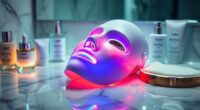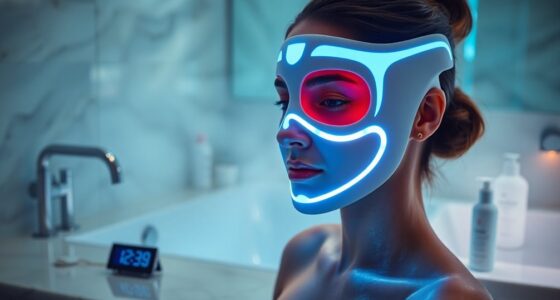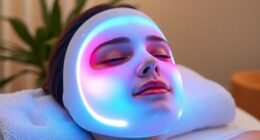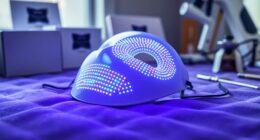Wearing an LED mask while you sleep can enhance your relaxation routine, but you should be cautious. Short sessions of about ten minutes are recommended for best results, as prolonged use can cause discomfort or irritation. It’s crucial to pay attention to your skin’s sensitivity and follow the manufacturer’s guidelines. If you’re looking to improve your sleep quality and unwind, you might want to know more about how to safely incorporate it into your routine.
Key Takeaways
- LED masks are designed for short sessions, typically around ten minutes, not for prolonged overnight wear.
- Prolonged use can lead to discomfort and skin irritation, disrupting sleep quality.
- Red light therapy can enhance relaxation and improve sleep quality when used correctly.
- It’s important to follow the manufacturer’s guidelines to avoid potential side effects.
- Monitor your personal response to the mask to determine if it suits your sleep routine.
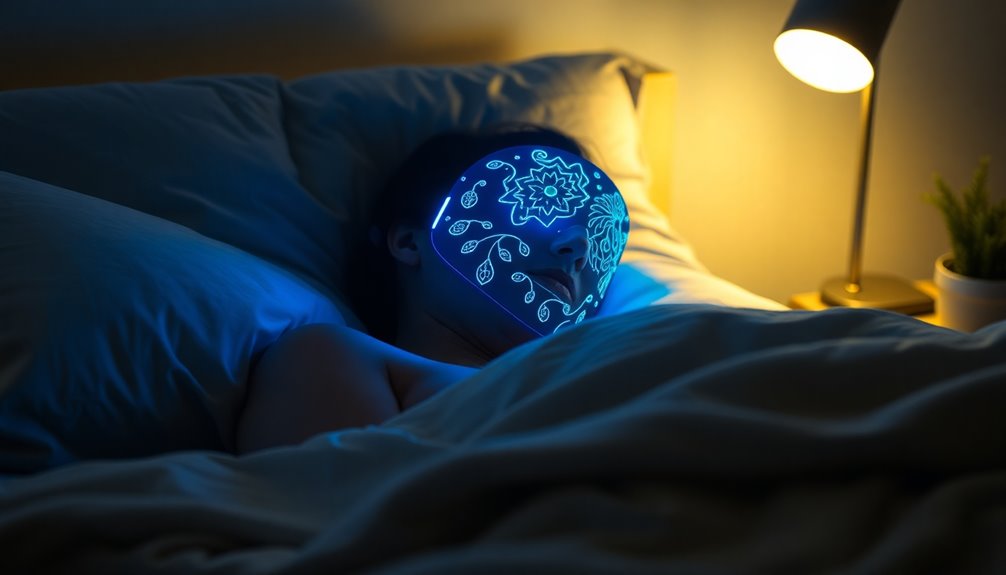
Have you ever wondered if you should wear an LED mask while you sleep? The idea of using LED masks before bedtime can be intriguing, especially when considering their potential benefits. These masks are designed to promote relaxation and improve sleep quality, making them appealing for anyone looking to enhance their nightly routine.
With features like red light therapy, they may help boost melatonin production, which plays a crucial role in regulating your sleep-wake cycle.
Using an LED mask in short sessions before sleep can significantly enhance your bedtime routine. You might find that just ten minutes of exposure helps induce a state of relaxation, making it easier for you to unwind after a long day. The red light therapy emitted by the mask can promote serotonin production, thereby reducing stress levels and creating a calming atmosphere as you prepare for sleep.
This pre-sleep ritual can’t only make falling asleep easier but may also improve your overall sleep quality.
However, while wearing an LED mask overnight might sound appealing, it’s generally not recommended. Prolonged use can lead to discomfort or skin irritation, which can disrupt your much-needed rest.
It’s essential to follow the manufacturer’s guidelines regarding the duration and frequency of use to avoid any potential side effects. Instead, consider incorporating short sessions into your routine. For example, you could wear the mask for about ten minutes while reading a book or meditating, allowing yourself to transition smoothly into sleep.
The benefits of red light therapy in LED masks extend beyond relaxation. By aiding in melatonin production, these masks can help regulate your sleep-wake cycle. This regulation is vital for achieving restorative sleep, which is essential for your overall health and well-being.
If you find it challenging to fall asleep or stay asleep, adding an LED mask to your pre-sleep ritual might be worth a try.
Frequently Asked Questions
Is Red Light Therapy Ok Before Bed?
Yes, red light therapy is perfectly fine to use before bed.
It doesn’t significantly affect your melatonin production like blue light does, and it might even enhance melatonin release, improving your sleep quality.
You’ll find that red light helps reduce sleep inertia, making you feel more alert when waking up.
Plus, it won’t disrupt your circadian rhythms, so incorporating it into your bedtime routine can promote relaxation and ease your transition to sleep.
Are You Supposed to Sleep With LED Lights On?
You shouldn’t sleep with LED lights on, as they can disrupt your sleep cycle and hinder melatonin production.
Blue light, in particular, is known to cause sleep disturbances. Instead, consider using dim red light if you need some illumination, as it’s less disruptive.
Ideally, you should limit all light exposure in the hour before bed to optimize your sleep hygiene and promote a more restful night’s sleep.
Should I Close My Eyes When Using a LED Mask?
Yes, you should close your eyes when using an LED mask. It helps protect your eyes from potential irritation caused by bright lights, especially blue light. In addition to closing your eyes, it’s advisable to limit your session duration to prevent any discomfort. While LED masks are generally considered safe, it’s important to stay informed about led light mask safety concerns that may arise from prolonged exposure. Always ensure that the mask is used according to the manufacturer’s instructions for the best results and to minimize any risks.
Keeping your eyes shut enhances relaxation and comfort, allowing you to enjoy the benefits of the mask fully.
Plus, many masks automatically turn off after a set time, so you can rest easy without worrying about unwanted light exposure disrupting your natural sleep-wake cycle.
Should I Use a LED Mask Morning or Night?
When deciding whether to use your LED mask in the morning or at night, think about what you want to achieve.
If you need a boost in mood and energy, morning sessions are great for stimulating serotonin production.
However, if you’re looking to promote relaxation and improve sleep quality, nighttime use is ideal, especially with red light therapy.
Consistent usage, no matter the time, can enhance both your skin health and overall well-being.
Conclusion
In conclusion, sleeping with an LED mask isn’t generally recommended. While these masks can offer benefits like skin rejuvenation, wearing one overnight might lead to discomfort or skin irritation. It’s best to use the mask for its intended duration, typically 10 to 30 minutes, and then remove it before you hit the pillow. Prioritizing your comfort and skin health will help you get a better night’s sleep without compromising the benefits of LED therapy.

